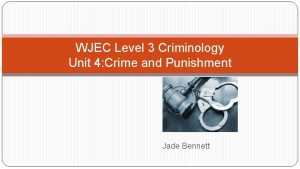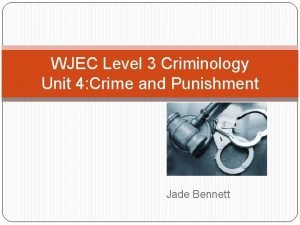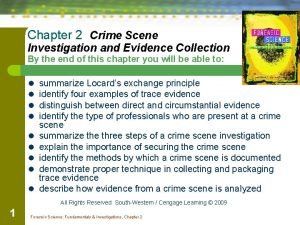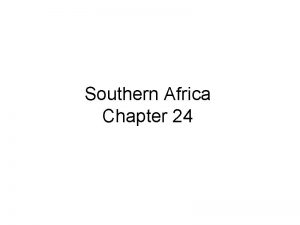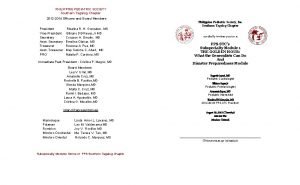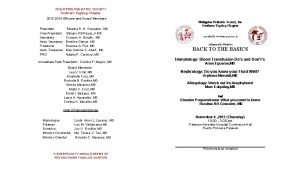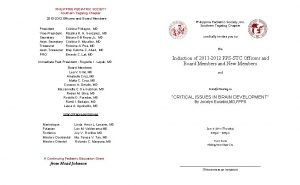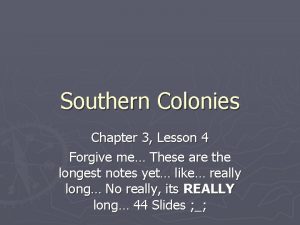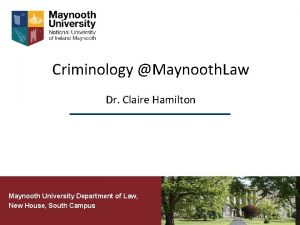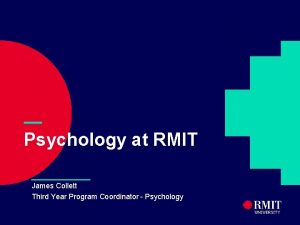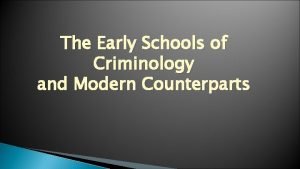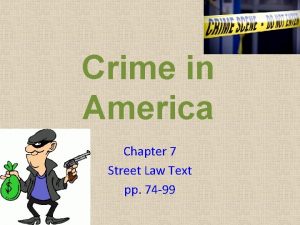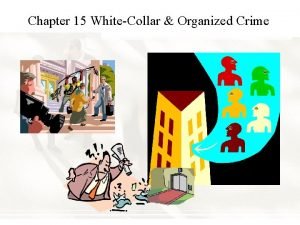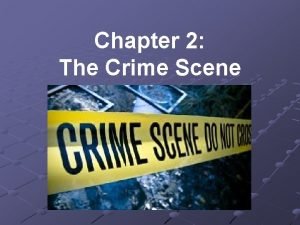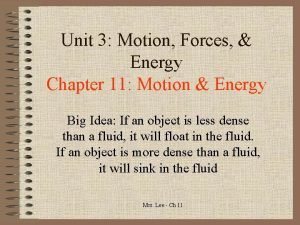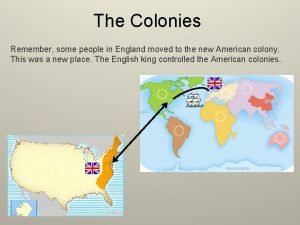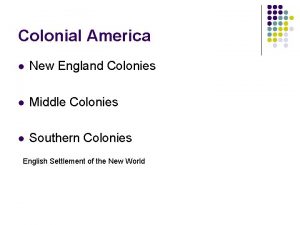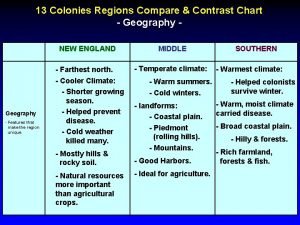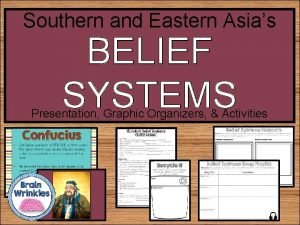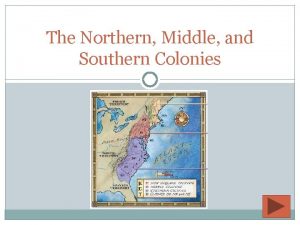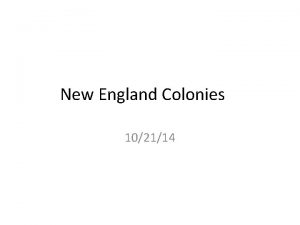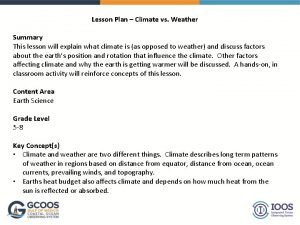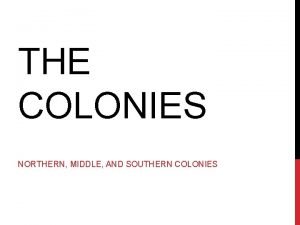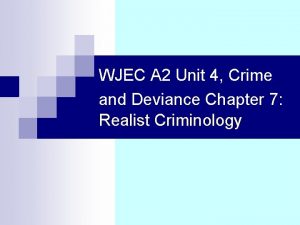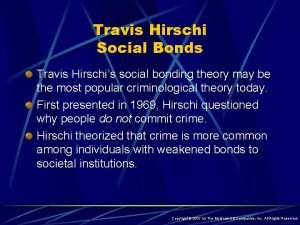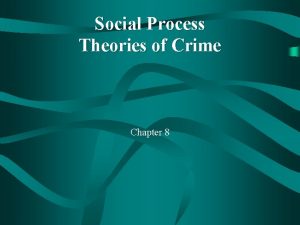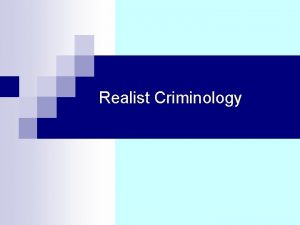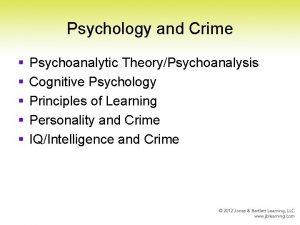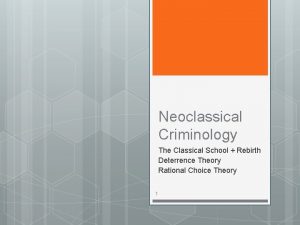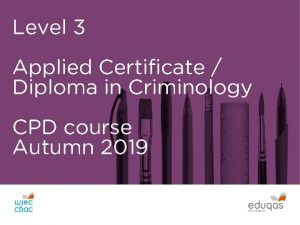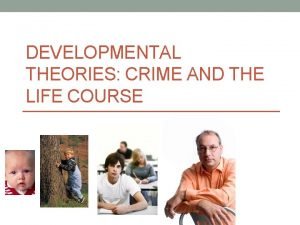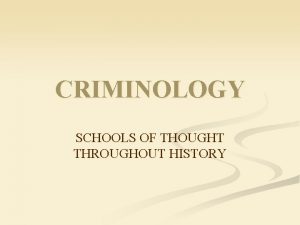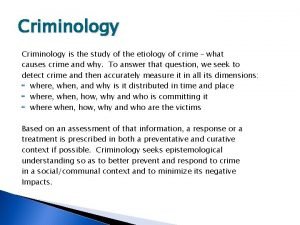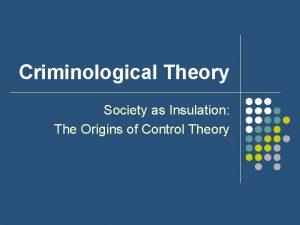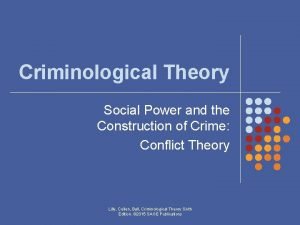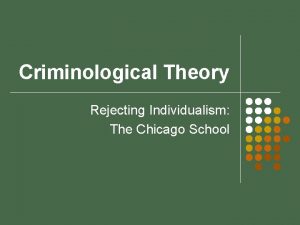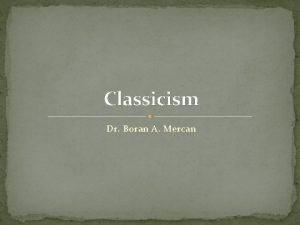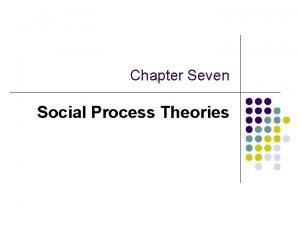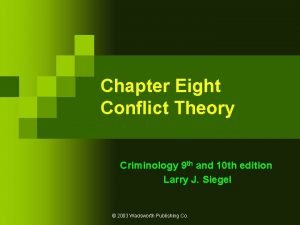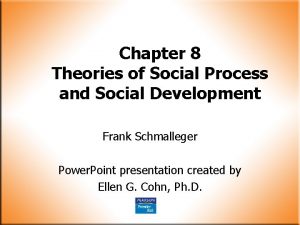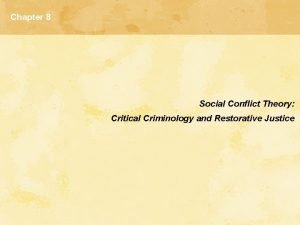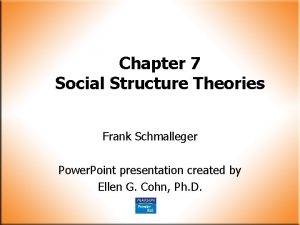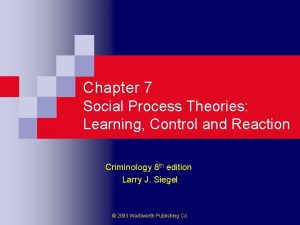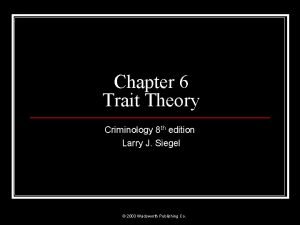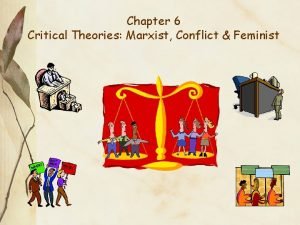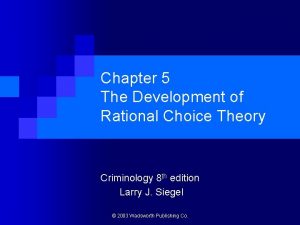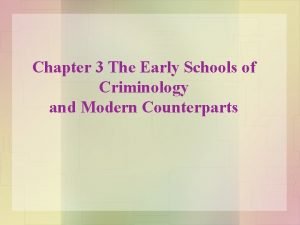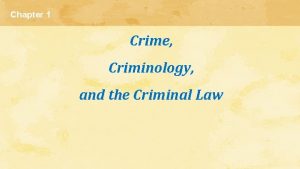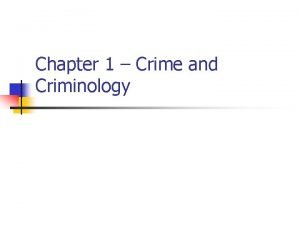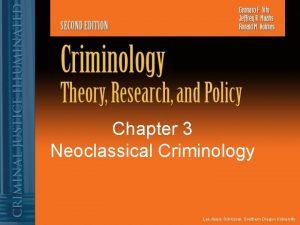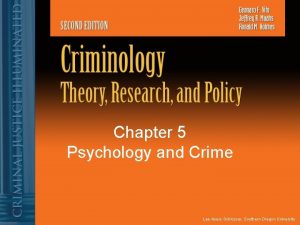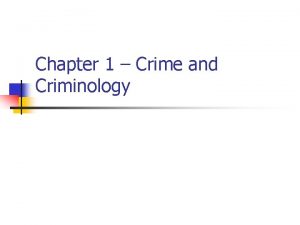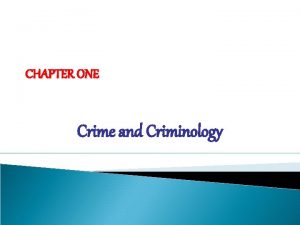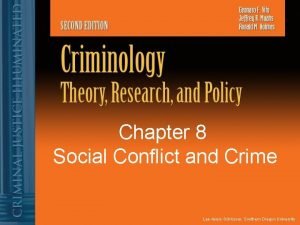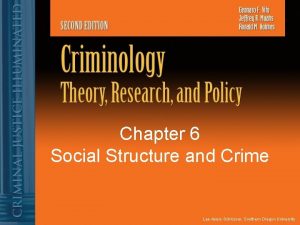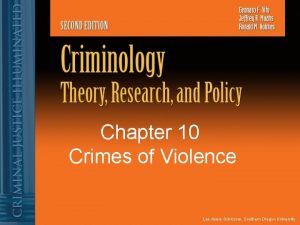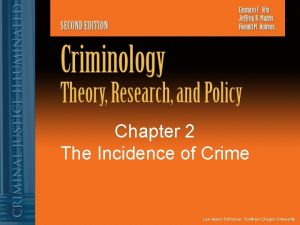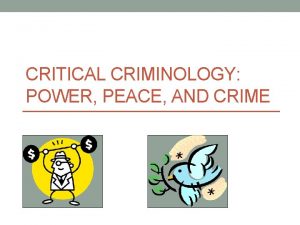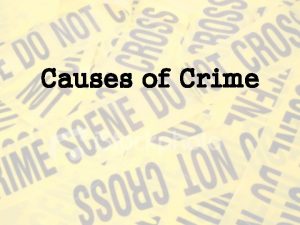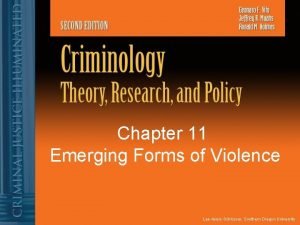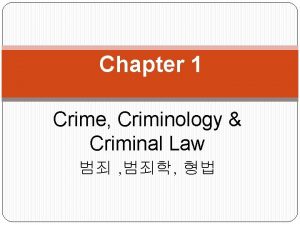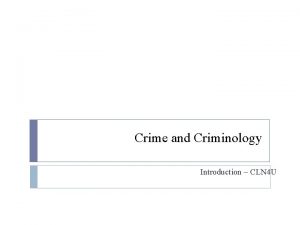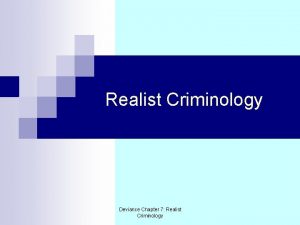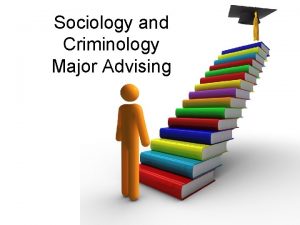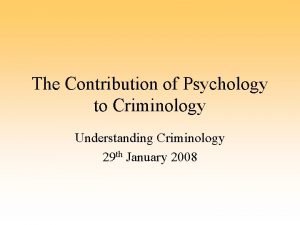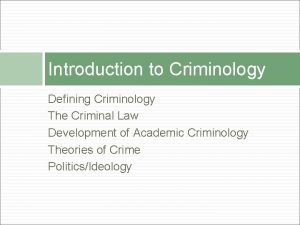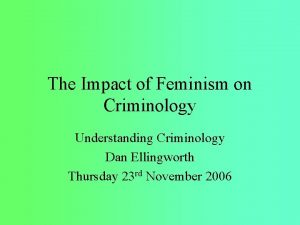Chapter 1 Crime and Criminology Lee AyersSchlosser Southern
































































- Slides: 64

Chapter 1 Crime and Criminology Lee Ayers-Schlosser, Southern Oregon University

Chapter Objectives (1 of 2) § Define criminology and understand how this field of study relates to other social science disciplines. § Understand the meaning of scientific theory and its relationship to research and policy. § Recognize a “good” theory of crime, based on criteria such as empirical support, scope, and parsimony.

Chapter Objectives (2 of 2) § Know the criteria for establishing causation and identify the attributes of good research. § Understand the politics of criminology and the importance of social context. § Define criminal law and understand the conflict and consensus perspectives on the law. § Describe the various schools of criminological theory and the explanations that they provide.

You Are the Criminologist Hackers § Illegal access to computer networks to gain information § Don’t think what they are doing is wrong—just “looking around” § How many people engage in hacking? § Why do certain people engage in hacking? § Why do some people commit crimes and others do not?

Introduction § § § Crime commands attention. Something must be done! Crime is not cheap! How do policy makers deal with crime? How do we explain criminal behavior? What are social reactions to crime?

Defining Criminology (1 of 3) § Criminology is the scientific study of crime. § Sutherland: Criminology is the study of law making, law breaking, and the response to law breaking.

Defining Criminology (2 of 3) § § Criminology: law breaking (the nature, extent, and causes of crime) Criminal justice: response to criminal behavior (policing, courts, and corrections)

Defining Criminology (3 of 3) § Overlap between criminology and criminal justice § Response to crime depends on one’s view of the cause of crime § Deviance—violating social norms

Criminology and Academics (1 of 2) § Criminology is organized around a class of behaviors (crime), not a way of understanding these behaviors (like other social sciences). § Social sciences organized on common: § Assumptions § Guiding insights § Specific research methodologies

Criminology and Academics (2 of 2) Discipline Area of Interest Psychology Intelligence Political science Voting behaviors Sociology Social movements

The Dominance of Sociology (1 of 2) § Ernest Burgess and W. I. Thomas § The Chicago School of Crime § Robert Merton § Anomie § Sociological imagination § Debunking motif

The Dominance of Sociology (2 of 2) § Sociology and Criminology § Distinct academic area § Independent degrees § Interdisciplinary study (sociology, biology, psychology)

The Role of Criminologists (1 of 2) § Role of criminologists § Study various aspects of criminal behavior and law-breaking dynamics § Manage research projects § Work for think tanks specializing in research and policy issues § Engage in scientific research

The Role of Criminologists (2 of 2) § Ph. D: use research expertise to study aspects of criminal behavior and lawbreaking dynamics § Master’s degree: positions in state and federal agencies within criminal justice system § Bachelor’s degree: entry-level positions within local, state, and federal agencies

A Primer on the Criminal Law § Criminologists do not typically receive extensive training in law. § The foundation of law is philosophy, not science. § JD or Doctorate of Juris Prudence (law degree) involves little, if any, scientific training.

Brief History of Criminal Law (1 of 3) § Dates back over 2000 years § Code of Hammurabi (1792 BC): the punishment should fit the crime § Mosaic Code of the Israelites (1200 BC): the Ten Commandments

Brief History of Criminal Law (2 of 3) § The root of American law is English common law. § Common law developed from English “circuit” courts and standardized legal code across different communities.

Brief History of Criminal Law (3 of 3) § Statutory law § Case law § Constitutional law

Defining the Criminal Law § Substantive criminal law § Prohibited behaviors § Possible sanctions § Each state has its own criminal code, as does the federal government.

Defining Crime (1 of 2) § Specific act (actus reas) § Criminal intent (mens rea)—a person’s mental state § § Purpose Knowledge Negligence Recklessness

Defining Crime (2 of 2) § Strict liability offenses (such as traffic offenses) do not require criminal intent. § Punishments can include imprisonment, fine, probation, etc.

Classification of Crime (1 of 2) § Mala in sec crimes (evil in themselves, such as homicide, robbery) vs. § Mala prohibita crimes (wrong because they are prohibited, such as gambling, prostitution)

Classification of Crime (2 of 2) § According to the seriousness of the offense (felony and misdemeanors) § According to degree (first-, second-, or third-degree offenses)

Procedural Law § What actions actors within the criminal justice system may legally take § For example: search-and-seizure law (how police interact with citizens) or how criminal trials proceed (admissibility of evidence)

Civil Law § Contract law § Property law § Tort law

Defining the Criminal Law § Laws are dynamic and influenced by: § § Current events Politics Economics Other external factors (e. g. , new technology)

Perspectives on the Criminal Law § Functions of criminal law § Discourage revenge § Express public opinion and morality § Warning to other citizens

Consensus Perspective § Laws are set to keep people from harming others. § Laws are in place to be fair to all members of society.

Conflict Perspective § Laws are the result of a continuous competition among members of society. § Laws reflect the interests, values, and beliefs of the group in power.

Defining Scientific Theory § A testable set of principles or statements that attempt to explain how concepts are related (e. g. , how one or more factors lead to criminal behavior) vs. § Circular (tautological) reasoning § Crime causes crime § Lack of conscience causes crime

Evaluating Theory (1 of 4) § Empirical evidence § When applied to the real world, does this theory work? § Does research support this theory? § Must consider the weight of the evidence.

Evaluating Theory (2 of 4)

Evaluating Theory (3 of 4) § Demonstrating cause and effect § Causal relationship (e. g. , hanging around with criminal friends causes criminal behavior) § Spurious—related factors but no causal relationship

Evaluating Theory (4 of 4) § Correlation § Having criminal friends is related to criminal behavior. § Time ordering § Having criminal friends happens before engaging in criminal behavior. § Longitudinal study (extended time period) § Relationship between criminal friends and criminal behavior is not spurious.

Experimental Design (1 of 2) § Most efficient way to: § Establish cause-and-effect relationships § Exclude spuriousness § Many theoretical concepts cannot be studied experimentally.

Experimental Design (2 of 2)

Nonexperimental Design (1 of 2) § Most crime research involves nonexperimental methods § Surveys and questionnaires § Common problem—useful to establish correlation but not effective to exclude spuriousness

Nonexperimental Design (2 of 2) § Demonstration of cause-and-effect relationships § Identify and measure those factors that might render a relationship spurious § Control for these factors in a mathematical model

Scope and Parsimony § Scope—what a particular theory can explain § Grand theories (wide scope)—try to explain all types of criminal behavior § Parsimony—simple formulation of a theory § Good theories have both large scope and parsimony (they explain a lot with few concepts)

Organizing Theories of Crime § Law breaking § Why do people commit crimes? § What makes some countries more prone to crime than others? § Law making § Why are some acts outlawed while others are not? § Why do legal acts become illegal over time? § Reaction to law breaking § Why do police arrest certain offenders and not others? § Why are certain laws enforced more stringently than others?

Macro and Micro Explanations § Micro level—why some individuals engage in crime and others do not § Most crime theories operate at the micro level § Macro level—explain differences in groups of people (e. g. , why some neighborhoods have higher crime rates)

Academic Disciplines and Theoretical Traditions § Traditions evolve § Basic thrust remains the same § Details updated or revised

Origins of Criminological Theory § Demonic perspective § Devil makes people commit crimes § Middle Ages—witches § Torture and corporal punishment

The Classical School of Crime (1 of 2) § The Age of Enlightenment § God instilled in humans the capacity to exercise free will and the ability to choose a course of behavior through reason.

The Classical School of Crime (2 of 2) § Beccaria: properly designed legal system will deter criminal behavior § Bentham: hedonistic calculus § Neoclassical theories

The Positive School of Crime § More rational, scientific understanding § Scientific method to study the causes of crime

The Classical and Positive School Positive Classical Rehabilitation Punishment Scientific determinism Free will Study of the individual Study of criminal law

Crime Policy (1 of 2) § Criminology = applied social science § Criminologists investigate crime in order to generate practical solutions to the problem.

Crime Policy (2 of 2) § Gibbs: major questions criminologists attempt to answer § Why does the crime rate vary? § Why are crimes committed by certain individuals and not others? § Why is there variation in reactions to alleged criminality? § What are the possible means of controlling criminality?

Policy Without Theory § Intensive supervision programs § Solution to crowding in American jails and prisons § Research initially found higher rates of probation revocation and little influence on recidivism. § Lack of any truly successful theory § Rehabilitative aspects of the program have been proven effective.

Theoretically Informed Policy § Multisystemic Therapy § Based on well-known and empirically tested theories

Limitations of Criminological Research § Most common conclusion of research is that more information is needed. Why? § Criminology is a part of the sociology research tradition. § Most criminological studies are based on limited data. § Criminological studies are not always methodologically sound. § Overgeneralization

Overgeneralization § Martinson report § Studies of felony probation—Rand Corporation in California § Impact of mandatory arrest in domestic violence cases—Sherman and Berk

Theory Versus Streetwise Criminology § Failure of criminology to provide certain clear-cut answers § Street smarts more valuable than book knowledge of criminal behavior

Politics: The “Left” and “Right” of Criminal Justice Policy (1 of 4) § Criminal justice policy fits within a political ideology § Relatively unquestioned assumptions about how the world works

Politics: The “Left” and “Right” of Criminal Justice Policy (2 of 4) § Political examples § Johnson “Great Society” § Distributive justice (increased economic opportunity best defense against crime) § Clinton § Community policing § Nixon, Ford, and Bush § Law-and-order stance emphasizing individual responsibility, deterrence, and retribution

Politics: The “Left” and “Right” of Criminal Justice Policy (3 of 4) Left (liberal) Right (conservative) Dissatisfied with present social order Crime = bad choice made freely by the offender Emphasizes dysfunctional elements of the Values discipline and criminal justice respect for authority system

Politics: The “Left” and “Right” of Criminal Justice Policy (4 of 4) Left (liberal) Right (conservative) Positive school Classical school Seeks root causes of Deals with symptoms criminal behavior of crime Calls for social reform Focuses on correlates of social problems

Influences of Social Context (1 of 2) § Social context shapes scientific research § Martinson report § Reviewed effectiveness of correctional treatment § Found that rehabilitative efforts had no appreciable effect upon recidivism

Influences of Social Context (2 of 2) § Social context impacts: § Which theories of crime gain popularity § How research findings are interpreted § What areas within criminology are deemed important enough to study

Crime as a Natural Phenomenon § Crime is something that can and must be eliminated. § Durkheim: Deviance is a prerequisite for social change. § Cohen: The deviant makes positive social contributions.

How to Study Crime (1 of 2) § Personal experience § Limited experiences § Limited perspective § Studies by others § Problems with generalizations § Interpretations subject to the influence of social context § Scientific method—best understanding § Construction of theory § Development of hypothesis § Empirical testing

How to Study Crime (2 of 2) § Keep an open mind. § Don’t discount theories based on exceptional cases—there always exceptions to the rule. § Don’t expect easy answers and don’t accept them without reservation— criminological theory often cannot provide literal answers to the crime problem. § Good theory should be linked to reality through research.

Conclusion § Crime should be viewed not as a single phenomenon, but as one in which many kinds of behavior occur in different situations and under different conditions. § No single theory can provide all the explanations or answers for crime. § Criminological theory attempts to explain the causes of criminal behavior, not to excuse crime or criminals.
 Criminology unit 4 crime and punishment
Criminology unit 4 crime and punishment Criminology unit 4 wjec
Criminology unit 4 wjec External forms of social control
External forms of social control Wjec criminology unit 1
Wjec criminology unit 1 Chapter 7 deviance crime and social control
Chapter 7 deviance crime and social control Locard exchange principle
Locard exchange principle Chapter 24 southern africa
Chapter 24 southern africa Pps southern tagalog chapter
Pps southern tagalog chapter Pps southern tagalog chapter
Pps southern tagalog chapter Jocelyn eusebio
Jocelyn eusebio Chapter 3 lesson 4 the southern colonies
Chapter 3 lesson 4 the southern colonies Dr claire hamilton
Dr claire hamilton Rmit applied science psychology
Rmit applied science psychology Classical and neoclassical theory criminology
Classical and neoclassical theory criminology Pre classical school of criminology
Pre classical school of criminology Chapter 7 crime in america
Chapter 7 crime in america Born a crime chapter 15 summary
Born a crime chapter 15 summary Chapter 2 the crime scene
Chapter 2 the crime scene Mrs lee chapter 11
Mrs lee chapter 11 Northern colonies
Northern colonies Southern and eastern asia map
Southern and eastern asia map Se asia geography cloze notes 1 answer key
Se asia geography cloze notes 1 answer key South asia physical features
South asia physical features Physical features of southern and eastern asia
Physical features of southern and eastern asia When was the new england colonies founded
When was the new england colonies founded 13 colonies religion chart
13 colonies religion chart In southern gothic atticus finch and miss maudie represent
In southern gothic atticus finch and miss maudie represent Se asia geography cloze notes 1
Se asia geography cloze notes 1 Brain wrinkles southern and eastern asia
Brain wrinkles southern and eastern asia Se asia's belief systems cloze notes
Se asia's belief systems cloze notes Northern middle southern colonies
Northern middle southern colonies New england, middle and southern colonies comparison chart
New england, middle and southern colonies comparison chart Parts of the globe
Parts of the globe Chapter 14 north and south
Chapter 14 north and south Southern and eastern asia physical features
Southern and eastern asia physical features Physical features of southern and eastern asia
Physical features of southern and eastern asia Northern and southern states
Northern and southern states Northern middle and southern colonies
Northern middle and southern colonies New england region
New england region Criminology unit 4 quiz
Criminology unit 4 quiz Hirschi bonds of attachment
Hirschi bonds of attachment Social process theories criminology
Social process theories criminology Realist criminology
Realist criminology Psychoanalytic theory criminology
Psychoanalytic theory criminology Neoclassical criminology
Neoclassical criminology Wjec criminology unit 3 answers
Wjec criminology unit 3 answers Developmental theories of crime
Developmental theories of crime Criminology schools of thought
Criminology schools of thought Etiology in criminology
Etiology in criminology Internal containment, external containment, self-insulation
Internal containment, external containment, self-insulation Conflict criminology
Conflict criminology Social disorganization theory
Social disorganization theory Classicism definition criminology
Classicism definition criminology What is social process theory
What is social process theory Questions about conflict theory
Questions about conflict theory Social process theories criminology
Social process theories criminology Left realists recognize street crime as
Left realists recognize street crime as Social structure theory crime
Social structure theory crime Primary and secondary deviance
Primary and secondary deviance The major premise of the biochemical theory is that
The major premise of the biochemical theory is that Masculinization theory criminology
Masculinization theory criminology Rational choice theory criminology
Rational choice theory criminology Lombroso biological positivism
Lombroso biological positivism What is criminology?
What is criminology? What is criminology?
What is criminology?
